There’s a myth that large ice cubes chill drinks just as effectively as small cubes while diluting them less, since they don’t melt as readily. This thinking ignores one of the basic laws of thermodynamics: Ice must melt in order to chill a liquid—and the more it melts, the colder the liquid will get. We set up a few tests to demonstrate this dynamic.
Why Dilution Is Key to Chilling Drinks
Published June 2, 2020.

Innovative Ice Cube Trays
No freezer is complete without a good ice tray. We tested some new designs that bring this kitchen must-have into the 21st century. Buy the WinnerTEST 1: Proving the critical role of dilution
We placed a single large ice cube in each of two glasses of 67-degree tap water. We wrapped one of the cubes tightly in plastic wrap to trap melted water and left the other cube unwrapped. Even without stirring (which we avoided so as not to hasten dilution), the temperature of the water containing the unwrapped cube plunged almost 20 degrees in the first minute, while the water with the wrapped cube dropped just 4 degrees. After 10 minutes, their temperatures were still more than 10 degrees apart, with the diluted water at 41 degrees and the undiluted water at 52 degrees.
TEST 2: Demonstrating the impact of ice cube size
We placed three small cubes in one glass of 67-degree water and one large cube totaling the same weight in a second glass of 67-degree water. It took a little more than a minute for the temperature of the water containing the small cubes to plunge well below 40 degrees, eventually leveling off. Meanwhile, the temperature of the water with the large cube never got below a comparatively tepid 43 degrees, even after 10 minutes.
Takeaway
Dilution is not only an inevitable part of chilling a drink with ice—it’s essential. (Even in the test with the wrapped cube, the ice needed to melt inside the plastic wrap to cool the water outside it.) That’s because ice doesn’t directly transfer its cold to a surrounding liquid. Instead heat, or energy, is drawn from the water and used to melt the surface of the ice. Since a greater surface area of ice means energy can be transferred faster, smaller ice cubes are much more efficient than large cubes at cooling a liquid.
Bottom Line
If you are interested in superchilling a drink such as iced tea quickly, use small ice cubes. For a less chilled (and less diluted) beverage such as an old-fashioned (where an overly cold temperature will mask flavors), use large cubes. (And if you want to learn to make ice of any size that’s crystal clear for cocktails, check out our method in this article.)






